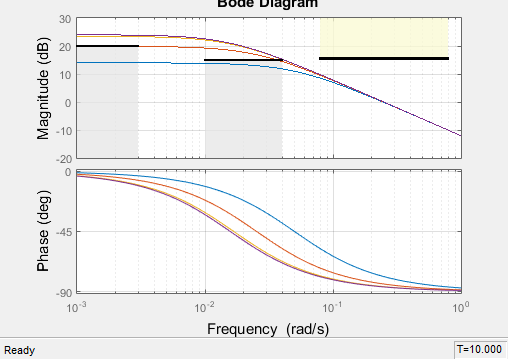Verify Model at Multiple Simulation Snapshots
This example shows how to:
Add multiple bounds.
Check that the linear system characteristics of a nonlinear Simulink® model satisfy the bounds at multiple simulation snapshots
Modify bounds graphically
Disable bounds during simulation
Open a nonlinear Simulink model. For example:
watertank
Open the Simulink Library Browser. In the Simulink Editor, on the Simulation tab, click Library Browser.
Add a model verification block to the Simulink model.
In the Simulink Control Design library, select Model Verification.

Drag and drop a block, such as the Check Bode Characteristics block, into the Simulink Editor.
The model now resembles the following figure.
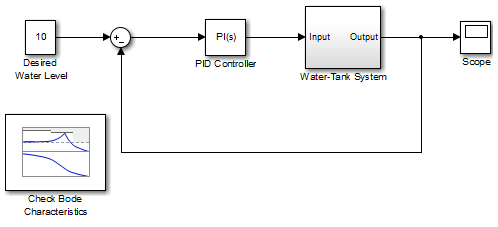
Double-click the block to open the Block Parameters dialog box.
To learn more about the block parameters, see the block reference pages.
Specify the linearization I/O points.
The linear system is computed for the Water-Tank System.
Tip
If your model already contains I/O points, the block automatically detects these points and displays them. Click
 at any time to update the
Linearization inputs/outputs table with I/Os from
the model.
at any time to update the
Linearization inputs/outputs table with I/Os from
the model.To specify an input:
Click
 adjacent to the
Linearization inputs/outputs
table.
adjacent to the
Linearization inputs/outputs
table.The Block Parameters dialog box expands to display a Click a signal in the model to select it area.
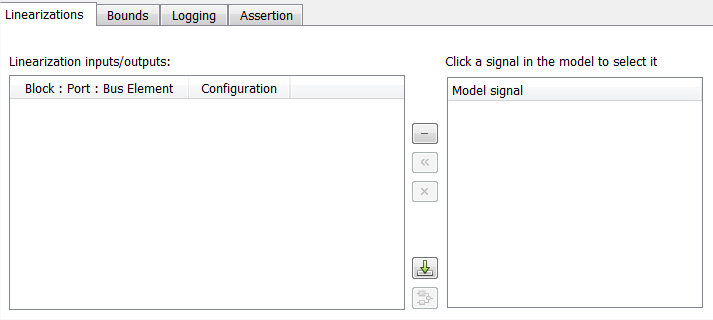
Tip
You can select multiple signals at once in the Simulink model. All selected signals appear in the Click a signal in the model to select it area.
In the Simulink model, click the output signal of the
PID Controllerblock to select it.The Click a signal in the model to select it area updates to display the selected signal.

Click
 to add the signal to the
Linearization inputs/outputs
table.
to add the signal to the
Linearization inputs/outputs
table.To remove a signal from the Linearization inputs/outputs table, select the signal and click
 .
.
To specify an output:
In the Simulink model, click the output signal of the
Water-Tank Systemblock to select it.The Click a signal in the model to select it area updates to display the selected signal.

Click
 to add the signal to the
Linearization inputs/outputs
table.
to add the signal to the
Linearization inputs/outputs
table.
To remove a signal from the Linearization inputs/outputs table, select the signal and click
 .
.Note
To find the location in the Simulink model corresponding to a signal in the Linearization inputs/outputs table, select the signal in the table and click
 .
.In the Configuration drop-down list of the Linearization inputs/outputs table, select
Open-loop Outputfor watertank/Water-Tank System : 1.
The Linearization inputs/outputs table now resembles the following figure.

Click
 to collapse the Click a
signal in the model to select it area.
to collapse the Click a
signal in the model to select it area.
Tip
Alternatively, before you add the Linear Analysis Plots block, right-click the signals in the Simulink model and select Linear Analysis Points > Input Perturbation and Linear Analysis Points > Open-loop Output. Linearization I/O annotations appear in the model and the selected signals appear in the Linearization inputs/outputs table.
Specify simulation snapshot times.
In the Linearizations tab, verify that
Simulation snapshotsis selected in Linearize on.In the Snapshot times field, type
[0 1 5 10].
Specify multiple bound segments for assertion in the Bounds tab of the Block Parameters dialog box. In this example, enter the following lower magnitude bounds:
Frequencies (rad/s) —
{[0.001 0.003],[0.01 0.04]}Magnitudes (dB) —
{[20 20],[15 15]}
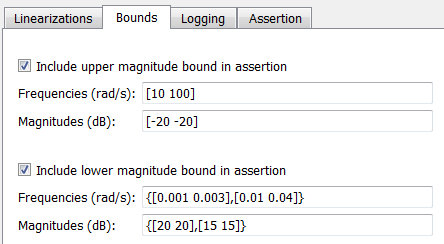
Click Apply to apply the parameter changes to the block.
Click Show Plot to view the bounds on the Bode magnitude plot.

Simulate the model by clicking
 in the plot window.
in the plot window.Alternatively, you can simulate the model from the Simulink Editor.
The software linearizes the portion of the model between the linearization input and output at the simulation times of 0,1, 5 and 10. When the software detects that the linear system computed at times 0 and 1 violate a specified lower magnitude bound, warning messages appear in the Diagnostic Viewer window. Click the link at the bottom of the Simulink model to open this window. Click the link in the window to view the details of the assertion.
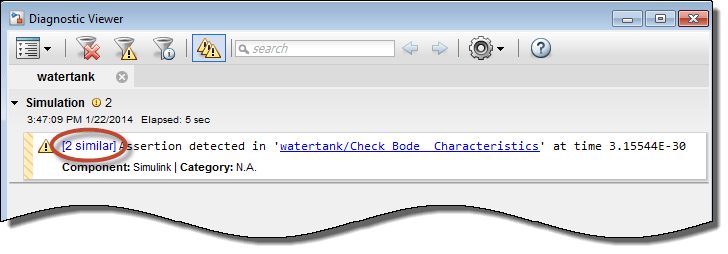
You can also view the bound violations on the plot window.
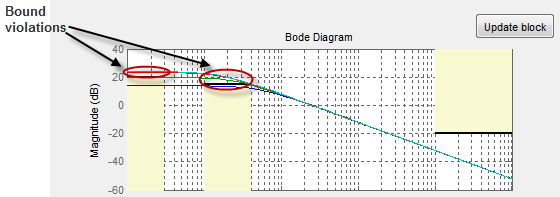
Modify a bound graphically. For example, to modify the upper magnitude bound graphically:
In the plot window, click the bound segment to select it and then drag it to the desired location.

Click Update block to update the new values in the Bounds tab of the Block Parameters dialog box.

Disable the lower bounds to exclude them from asserting. Clear the Include lower magnitude bounds in assertion option in the Block Parameters dialog box. Then, click Apply.
The lower bounds are now grey-out in the plot window, indicating that they are excluded from assertion.

Resimulate the model to check if bounds are satisfied.
The software satisfies the specified upper magnitude bound, and therefore the software no longer reports an assertion failure.
